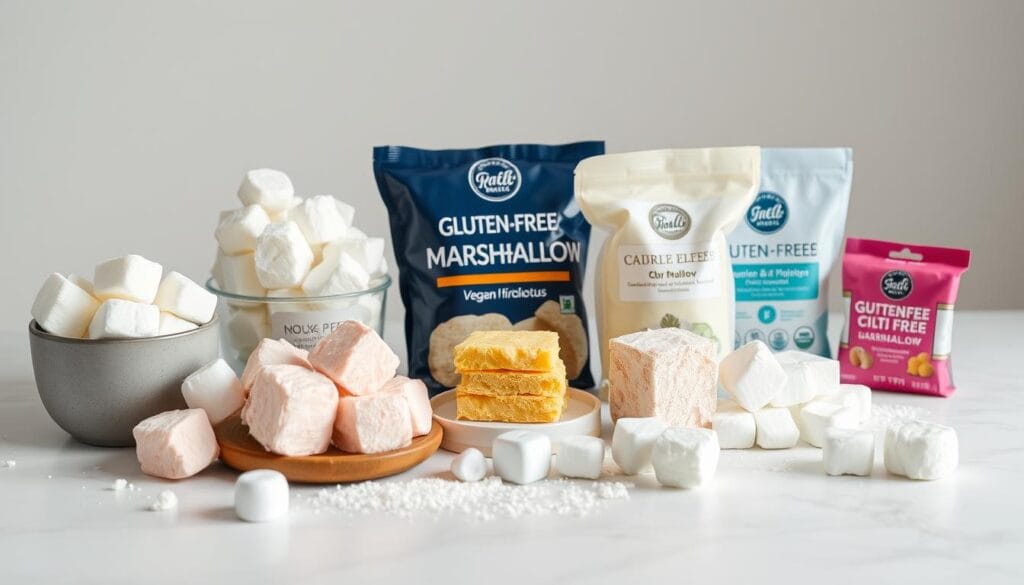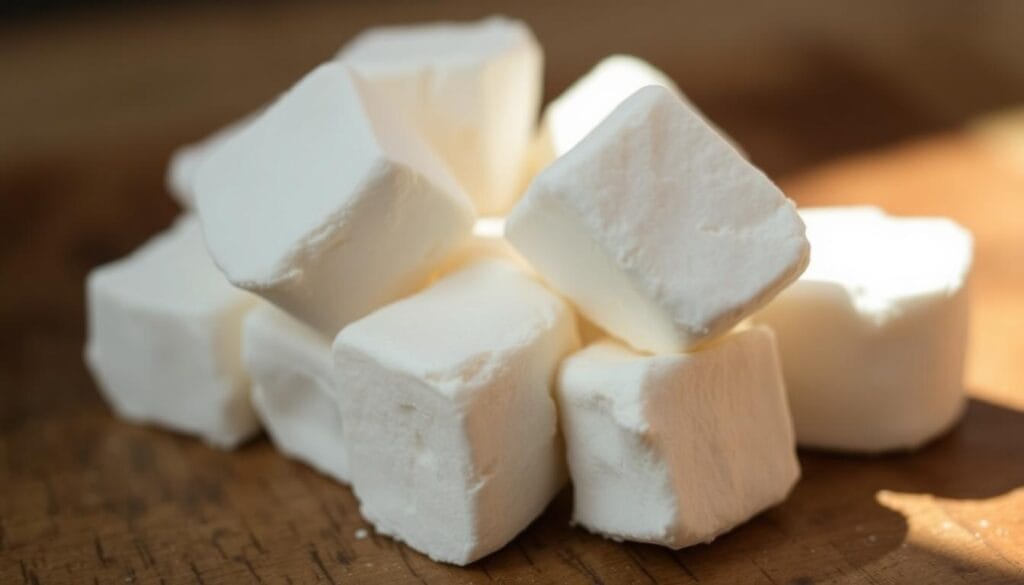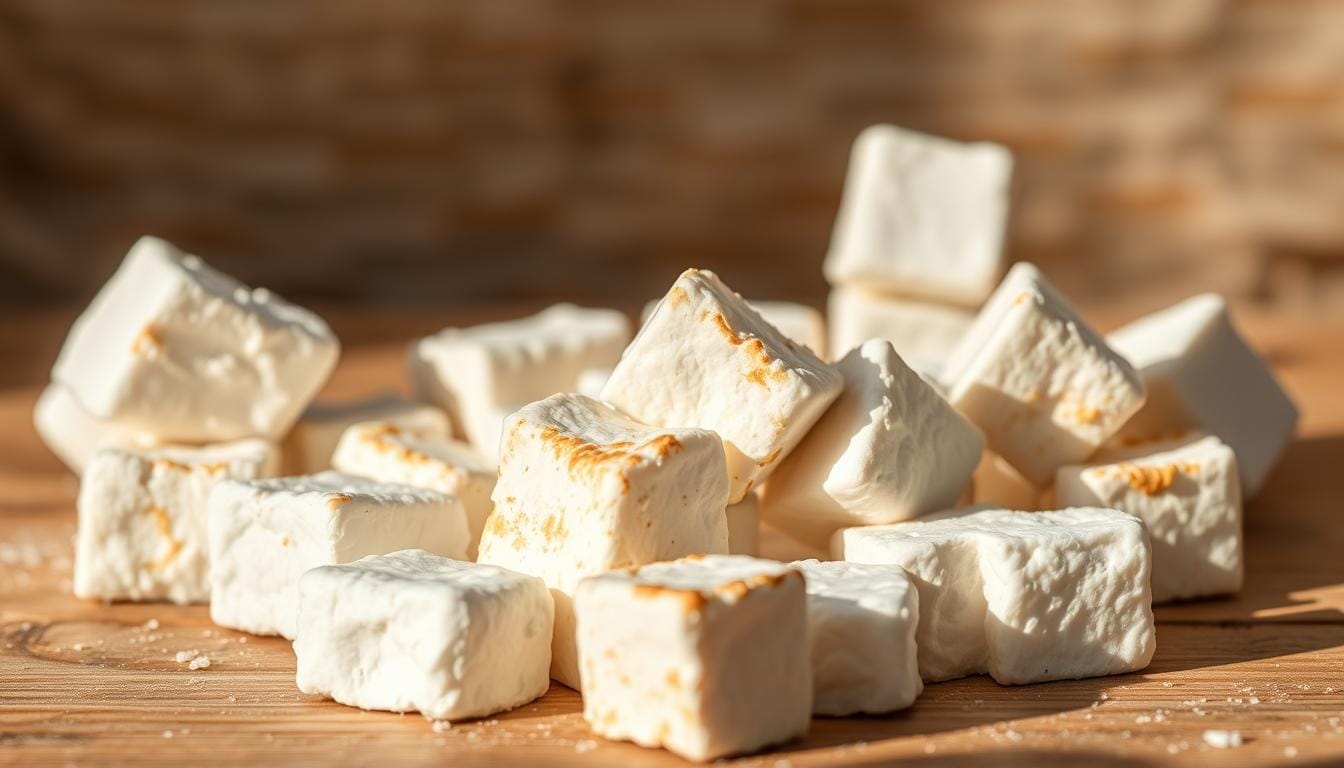Wondering if marshmallows are gluten-free? The answer isn’t simple. It depends on what’s in them and how they’re made. Marshmallows without gluten usually have sugar, corn syrup, and gelatin. But, some might have gluten because of how they’re made or what they’re mixed with.
If you need gluten-free marshmallows, always check the labels. Look into who makes them to make sure they’re safe for you.
For those with gluten allergies or intolerance, knowing what makes marshmallows safe is key. You need to spot gluten in ingredients and understand how it might sneak in. This guide will cover gluten-free marshmallows, what’s in them, and how they’re made. We’ll also teach you how to spot gluten-free labels and products.
Key Takeaways
- Most marshmallows are gluten-free, but it’s crucial to check the ingredients and manufacturing process.
- Marshmallows without gluten are made from simple ingredients like sugar, corn syrup, and gelatin.
- Gluten-free marshmallows can be found in various products, including Rice Krispies treats made with rice syrup instead of malt syrup.
- Reading labels and researching the manufacturer is essential to ensure the marshmallows meet your dietary needs.
- Certified gluten-free products can help you make informed decisions about the marshmallows you consume.
- Are marshmallows gluten free? The answer depends on the specific product and manufacturer.
- Gluten free marshmallows are available in various forms, including marshmallow crisps and gluten-free candy bars.
Understanding Marshmallows and Their Basic Composition
Marshmallows have been loved for centuries. They are made from gelatin, sugar, and corn syrup, which are gluten-free ingredients in marshmallows. But, modern making might add gluten in marshmallows through cross-contamination or additives. Knowing the traditional ingredients and modern making is key to understanding the gluten content in marshmallows.
A classic marshmallow recipe has 60% corn syrup, 30% sugar, and 1-2% gelatin. Adding acid, like cream of tartar or lemon juice, helps the foam but might slow its formation. Marshmallows are very moist, thanks to gelatin, which keeps them soft.
Some interesting facts about marshmallows are:
* A single serving of marshmallows weighs about 28 grams
* Marshmallows are about 50% air, making them light and fluffy
* Today, making marshmallows can produce thousands of pounds daily, thanks to new technology
Knowing how marshmallows are made helps you choose the right ones. You can pick gluten-free ingredients in marshmallows that fit your diet.
Are Marshmallows Gluten Free? The Simple Answer
Most marshmallows are naturally gluten-free. But, people with severe gluten allergies need to be careful. This is because of the risk of cross-contamination during making.
If you’re wondering are marshmallows safe for gluten allergies, the answer is mostly yes. But, it’s important to pick a brand that works hard to avoid cross-contamination.
Some well-known gluten free options for marshmallows are Kraft Jet-Puffed, Dandies, and Campfire. These brands have gluten-free marshmallow products. This makes it easier for those with gluten allergies to enjoy their favorite treats.
When looking for gluten-free marshmallows, always check the ingredients. Also, look for certification from trusted organizations. This ensures the product fits your dietary needs.
In short, while marshmallows are usually gluten-free, being careful is key. Choose a brand that offers gluten free options for marshmallows. This way, you can enjoy marshmallow treats while keeping your diet gluten-free.
If you have a severe gluten allergy, always talk to the manufacturer or a doctor. They can help make sure the marshmallows you pick are safe for you.
The Science Behind Marshmallow Production
Understanding marshmallow production is key when following a gluten-free diet. Marshmallows are made from sugar, water, and gelatin. These are all gluten-free. But, the way these ingredients are processed can lead to gluten contamination.
The making of marshmallows starts with heating sugar syrup to 115°C (240°F). It’s mixed with gelatin and water. For homemade marshmallows, you need 1½ cups of sugar, 1 cup of corn syrup, and ½ cup of water. Gelatin is added at a ratio of 2½ tablespoons per ½ cup of cold water.
To avoid gluten contamination, it’s important to use gluten-free ingredients. Also, follow strict manufacturing practices. Brands like Kraft Jet-Puffed and Dandies offer gluten-free marshmallows. Always check the packaging for ingredient updates.
If you have dietary restrictions, knowing what goes into marshmallows is crucial. By choosing gluten-free ingredients, you can enjoy marshmallows while sticking to your gluten-free diet.
Common Sources of Hidden Gluten in Candy Products
When we talk about gluten in marshmallows, we must look at candy products as a whole. Marshmallows themselves are gluten-free, but the candies they’re in might not be. Knowing these risks is key to staying safe.
Gluten in marshmallows can come from shared equipment, cross-contamination, and additives. Some makers use gluten-containing starch or dextrin. Also, foods like lunch meats, meatballs, and soy sauce can hide gluten.
Here are some common sources of hidden gluten in candy products:
- Shared equipment and cross-contamination during manufacturing
- Certain additives, such as starch or dextrin, obtained from wheat or barley
- Hidden gluten sources in food products, such as lunch meats and soy sauce
It’s important to be careful and check labels for gluten-free certifications. This way, you can enjoy your treats while keeping your diet gluten-free.
Even if a product says it’s gluten-free, there’s still a chance of cross-contamination. Always put your health first by staying informed and careful.
Reading Marshmallow Labels for Gluten Content
When you’re looking for marshmallows, it’s key to check the labels. This ensures you get ones that are gluten-free. Most marshmallows are made from sugar, water, and gelatin, which don’t have gluten. But, some might have gluten because of how they’re made or added ingredients.
To know if a marshmallow is gluten-free, look for special labels. The Gluten-Free Certification Organization (GFCO) or the Celiac Support Association (CSA) are good ones. Also, check the ingredients list for anything with gluten.
Key Terms to Look For
Here are some important terms to find on marshmallow labels:
- Gluten-free
- Gluten-free certification
- Ingredients: sugar, water, gelatin
Warning Signs of Gluten Presence
Watch out for these signs that a marshmallow might have gluten:
- Ingredients like wheat, barley, or rye
- Warnings about cross-contamination
- No gluten-free certification
Understanding Certification Labels
Certification labels like GFCO or CSA mean a product is gluten-free. Look for these when buying gluten-free marshmallows. They help you know you’re getting a safe choice.
By carefully reading marshmallow labels and looking for specific terms and certifications, you can enjoy gluten-free marshmallows safely. Always check the ingredients list and watch for gluten warning signs to stay safe.
Major Marshmallow Brands and Their Gluten Status
Many big brands offer marshmallows without gluten. You can trust Dandies, Trader Joe’s, Kraft, Smashmallow, and Campfire. They make marshmallows without gluten. Jet Puffed Marshmallows are also gluten-free, as they don’t have wheat, barley, rye, or gluten.
Popular gluten-free mini marshmallow brands include Kraft Jet-Puffed, Dandies, and Campfire. It’s key to find certified gluten-free products, especially if you’re very sensitive to gluten. Marshmallow Fluff is also gluten-free, made with corn syrup, sugar, egg whites, and vanillin.

Brands like Suzanne’s Specialties and Let’s Do Organic offer gluten-free alternatives. They have Rice Mellow and Sweetened Condensed Coconut Milk. Soyatoo Soy Whip is another option that’s gluten-free and dairy-free, great as a marshmallow cream substitute. Always check the label for the latest info on gluten content and cross-contamination.
About 13% of the world’s people are gluten sensitive. It’s important to have gluten-free marshmallow options. By choosing gluten-free brands, you can enjoy your treats without gluten worries. Always check the gluten status of each product for your safety and happiness.
Cross-Contamination Concerns in Marshmallow Production
Gluten in marshmallows is a big worry. Cross-contamination can happen at many steps in making them. This is because shared equipment and not cleaning well can spread gluten.
How marshmallows are made can affect their gluten levels. To avoid cross-contamination, makers use special lines and clean often. They also use special tools to check for gluten.
Manufacturing Facility Practices
How facilities make marshmallows is key to avoiding cross-contamination. They clean well and use only certain equipment. They also test their marshmallows to make sure they’re gluten-free.
Shared Equipment Issues
Shared equipment can spread gluten. If it’s not cleaned right, gluten can move from one thing to another. So, makers use only certain equipment for gluten-free marshmallows.
Storage and Transportation Risks
Storing and moving marshmallows can also be risky. If they’re near gluten, they can get contaminated. To avoid this, makers use special places for gluten-free items.
Knowing about cross-contamination helps us enjoy gluten-free marshmallows safely. Always check the label and choose makers who focus on gluten-free.
Homemade Gluten-Free Marshmallow Recipes
Following a gluten-free diet can make it hard to find marshmallows that fit your needs. But, making your own gluten-free marshmallows is fun and easy. With a few simple ingredients, you can make tasty and safe treats. This way, a gluten-free diet and marshmallows can go hand in hand.
To start, you need just 5 ingredients, like gelatin and sugar. The prep time is under 20 minutes. The whole process takes about 5 hours and 30 minutes, including resting time. You’ll get 25 servings of marshmallows, each with about 97 calories. You can also add flavors like strawberry or chocolate.
Here are some tips for making gluten-free marshmallows at home:
- Use a 9×9 inch pan for thicker marshmallows or a 13×9 inch pan for thinner ones.
- Boil the sugar syrup to 242°F for the best results.
- Let the marshmallows cool and set for at least 5 hours or overnight.
- Store your homemade marshmallows at room temperature for up to 2 weeks.
By following these simple steps and using gluten-free ingredients, you can enjoy delicious treats. Homemade marshmallows can become a part of your daily life again.
Special Dietary Considerations Beyond Gluten
When looking at gluten free marshmallows, think about other dietary needs too. Many people have more than one dietary restriction. Knowing this helps you make better choices.
If you’re wondering are marshmallows gluten free, you might also want to explore other options. This includes gluten free marshmallows that are vegan, kosher, or sugar-free.
These alternatives can be just as tasty as regular marshmallows. It’s important to check labels and look for the right certifications. This ensures they meet your dietary needs.

- Vegan options: Many gluten free marshmallows are now vegan, made with plant-based ingredients.
- Kosher considerations: Some people need kosher certification for their gluten free marshmallows.
- Sugar-free alternatives: For those who can’t have sugar, there are gluten free marshmallows with alternative sweeteners.
By considering these special dietary needs, you can find gluten free marshmallows that fit your lifestyle. Whether you’re looking for vegan, kosher, or sugar-free options, there are many choices out there.
Safe Ways to Enjoy Marshmallows on a Gluten-Free Diet
Following a gluten-free diet means being careful about what you eat, including marshmallows. Luckily, there are many gluten free options for marshmallows out there. This makes it easy to enjoy marshmallows while sticking to your diet.
To safely enjoy marshmallows on a gluten free diet, consider these tips:
- Choose marshmallows from reputable brands that offer gluten free options.
- Always read labels carefully to ensure that the marshmallows do not contain gluten or have been processed in a facility that also handles gluten-containing products.
- Be aware of potential cross-contamination risks, especially when consuming marshmallows in public places or at social gatherings.
Some popular gluten free options for marshmallows include Kraft Jet-Puffed, Dandies, and Campfire. These brands have a variety of gluten-free marshmallow products. They’re great for snacking, baking, or making s’mores.
By being mindful of the gluten free options for marshmallows and taking steps to minimize cross-contamination risks, you can enjoy marshmallows while following a gluten free diet. Always prioritize your dietary needs and take the necessary precautions to ensure your safety and well-being.
Popular Marshmallow-Based Treats and Their Gluten Status
Enjoying marshmallow-based treats on a gluten-free diet requires careful consideration. Many treats, like s’mores, Rice Krispy treats, and hot chocolate, can be gluten-free. This is thanks to the use of gluten-free marshmallows.
For example, gluten free marshmallows can turn s’mores into a gluten-free delight. Pair them with gluten-free graham crackers and chocolate for a worry-free treat. Rice Krispy treats can also be gluten-free, using are marshmallows gluten free and gluten-free cereal.
Hot chocolate can be made with gluten-free marshmallows too. This makes it a comforting drink for those on a gluten-free diet. Just be sure to check the ingredients and avoid cross-contamination.
There are also gluten-free alternatives to traditional marshmallow treats. Dandies Vegan Marshmallow Dip and Suzanne’s Specialties Rice Mellow are great options. They’re made with gluten free marshmallows and can be used to make s’mores and Rice Krispy treats. They’re perfect for those with gluten intolerance or sensitivity.
Seasonal Marshmallow Products and Gluten Concerns
Seasonal marshmallow products can have unique gluten concerns. This is because of different ingredients and how they are made. Knowing about these concerns helps you find gluten-free marshmallows in the seasonal market.
Candy companies like Hershey’s and Ferrara have gluten-free options. But, it’s important to check the labels and look for certifications. This ensures the product fits your dietary needs. The gluten content in marshmallows can change a lot depending on who makes them and what they use.
To make good choices, follow these tips:
- Always check the ingredient label for gluten in marshmallows
- Look for certifications from reputable organizations
- Be aware of potential cross-contamination risks
By being careful, you can enjoy seasonal marshmallow treats while staying gluten-free. Always keep your dietary needs in mind and stay informed.
Storage Tips for Maintaining Gluten-Free Status
Storing gluten-free marshmallows right is key to keeping them safe for those on a gluten-free diet. It’s important to avoid cross-contamination. This way, you can enjoy marshmallows made with gluten-free ingredients for longer.
Use airtight containers or resealable bags to store them. Keep them in a cool, dry spot to prevent stickiness. Freezing them can extend their shelf life up to 3 months.
Here are some tips for storing gluten-free marshmallows:
- Use airtight containers or resealable plastic bags to prevent moisture and air from getting in.
- Store them in a cool, dry place to prevent them from becoming sticky or losing their shape.
- Consider freezing them if you want to keep them for a longer period.
- Use parchment paper or wax paper to prevent marshmallows from sticking together.
By following these tips, you can enjoy your gluten-free marshmallows while keeping them safe for your gluten-free diet. Always check labels and look for certifications. This ensures the marshmallows are made with gluten-free ingredients.
| Storage Method | Shelf Life |
|---|---|
| Airtight container | 1-2 weeks |
| Refrigerated | 2-3 weeks |
| Frozen | Up to 3 months |
When to Be Extra Cautious About Marshmallow Consumption
It’s important to know when to be careful with marshmallows, especially for those with gluten allergies. Are marshmallows safe for gluten allergies depends on the marshmallow type and the person’s sensitivity.
Gluten free options for marshmallows are out there, but always check the ingredients and labels. When eating out or traveling, be extra careful. Cross-contamination can happen easily.
Some situations that need extra caution include:
- Eating at restaurants that may not have gluten-free options or proper cross-contamination protocols
- Traveling to foreign countries where gluten-free options may be limited
- Consuming marshmallows that may have been processed in facilities that also handle gluten-containing products
By knowing these situations and taking precautions, people with gluten allergies or sensitivities can enjoy marshmallows safely.
Tips for Buying Gluten-Free Marshmallows
When you’re looking for gluten-free marshmallows, there are a few things to remember. First, find reliable stores that sell gluten-free items. Brands like Kraft, Dandies, and Campfire are known for their gluten-free marshmallows. You can find them at big grocery stores, health food shops, or online.
Think about the cost of gluten-free marshmallows too. They might be pricier than regular ones, but it’s worth it for the safety. If you use marshmallows a lot, buying in bulk can help save money.
Also, remember how to store gluten-free marshmallows to keep them fresh. Use airtight containers and keep them away from humid places. This way, you can enjoy your marshmallow treats safely and without worry.
FAQ
Are marshmallows gluten-free?
What ingredients in marshmallows can contain gluten?
How can I identify gluten-free marshmallows?
Are there any major marshmallow brands that offer gluten-free options?
Can homemade marshmallows be made gluten-free?
What are some special dietary considerations for gluten-free marshmallows?
How can I safely enjoy marshmallows on a gluten-free diet?
Table of Contents
Did you like this recipe?
There are no reviews yet. Be the first one to write one.

